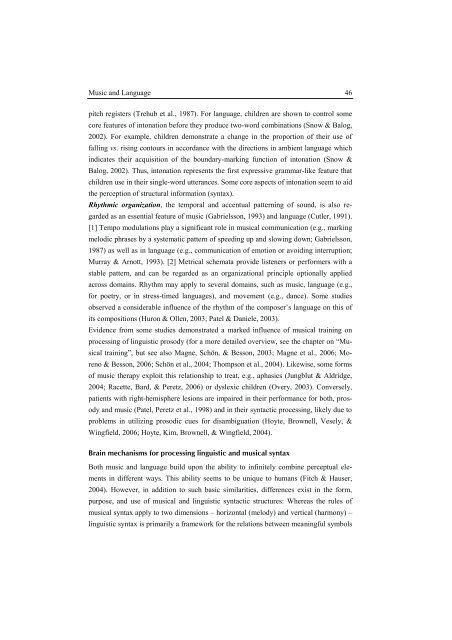Neural Correlates of Processing Syntax in Music and ... - PubMan
Neural Correlates of Processing Syntax in Music and ... - PubMan
Neural Correlates of Processing Syntax in Music and ... - PubMan
Create successful ePaper yourself
Turn your PDF publications into a flip-book with our unique Google optimized e-Paper software.
<strong>Music</strong> <strong>and</strong> Language 46<br />
pitch registers (Trehub et al., 1987). For language, children are shown to control some<br />
core features <strong>of</strong> <strong>in</strong>tonation before they produce two-word comb<strong>in</strong>ations (Snow & Balog,<br />
2002). For example, children demonstrate a change <strong>in</strong> the proportion <strong>of</strong> their use <strong>of</strong><br />
fall<strong>in</strong>g vs. ris<strong>in</strong>g contours <strong>in</strong> accordance with the directions <strong>in</strong> ambient language which<br />
<strong>in</strong>dicates their acquisition <strong>of</strong> the boundary-mark<strong>in</strong>g function <strong>of</strong> <strong>in</strong>tonation (Snow &<br />
Balog, 2002). Thus, <strong>in</strong>tonation represents the first expressive grammar-like feature that<br />
children use <strong>in</strong> their s<strong>in</strong>gle-word utterances. Some core aspects <strong>of</strong> <strong>in</strong>tonation seem to aid<br />
the perception <strong>of</strong> structural <strong>in</strong>formation (syntax).<br />
Rhythmic organization, the temporal <strong>and</strong> accentual pattern<strong>in</strong>g <strong>of</strong> sound, is also regarded<br />
as an essential feature <strong>of</strong> music (Gabrielsson, 1993) <strong>and</strong> language (Cutler, 1991).<br />
[1] Tempo modulations play a significant role <strong>in</strong> musical communication (e.g., mark<strong>in</strong>g<br />
melodic phrases by a systematic pattern <strong>of</strong> speed<strong>in</strong>g up <strong>and</strong> slow<strong>in</strong>g down; Gabrielsson,<br />
1987) as well as <strong>in</strong> language (e.g., communication <strong>of</strong> emotion or avoid<strong>in</strong>g <strong>in</strong>terruption;<br />
Murray & Arnott, 1993). [2] Metrical schemata provide listeners or performers with a<br />
stable pattern, <strong>and</strong> can be regarded as an organizational pr<strong>in</strong>ciple optionally applied<br />
across doma<strong>in</strong>s. Rhythm may apply to several doma<strong>in</strong>s, such as music, language (e.g.,<br />
for poetry, or <strong>in</strong> stress-timed languages), <strong>and</strong> movement (e.g., dance). Some studies<br />
observed a considerable <strong>in</strong>fluence <strong>of</strong> the rhythm <strong>of</strong> the composer’s language on this <strong>of</strong><br />
its compositions (Huron & Ollen, 2003; Patel & Daniele, 2003).<br />
Evidence from some studies demonstrated a marked <strong>in</strong>fluence <strong>of</strong> musical tra<strong>in</strong><strong>in</strong>g on<br />
process<strong>in</strong>g <strong>of</strong> l<strong>in</strong>guistic prosody (for a more detailed overview, see the chapter on “<strong>Music</strong>al<br />
tra<strong>in</strong><strong>in</strong>g”, but see also Magne, Schön, & Besson, 2003; Magne et al., 2006; Moreno<br />
& Besson, 2006; Schön et al., 2004; Thompson et al., 2004). Likewise, some forms<br />
<strong>of</strong> music therapy exploit this relationship to treat, e.g., aphasics (Jungblut & Aldridge,<br />
2004; Racette, Bard, & Peretz, 2006) or dyslexic children (Overy, 2003). Conversely,<br />
patients with right-hemisphere lesions are impaired <strong>in</strong> their performance for both, prosody<br />
<strong>and</strong> music (Patel, Peretz et al., 1998) <strong>and</strong> <strong>in</strong> their syntactic process<strong>in</strong>g, likely due to<br />
problems <strong>in</strong> utiliz<strong>in</strong>g prosodic cues for disambiguation (Hoyte, Brownell, Vesely, &<br />
W<strong>in</strong>gfield, 2006; Hoyte, Kim, Brownell, & W<strong>in</strong>gfield, 2004).<br />
Bra<strong>in</strong> mechanisms for process<strong>in</strong>g l<strong>in</strong>guistic <strong>and</strong> musical syntax<br />
Both music <strong>and</strong> language build upon the ability to <strong>in</strong>f<strong>in</strong>itely comb<strong>in</strong>e perceptual elements<br />
<strong>in</strong> different ways. This ability seems to be unique to humans (Fitch & Hauser,<br />
2004). However, <strong>in</strong> addition to such basic similarities, differences exist <strong>in</strong> the form,<br />
purpose, <strong>and</strong> use <strong>of</strong> musical <strong>and</strong> l<strong>in</strong>guistic syntactic structures: Whereas the rules <strong>of</strong><br />
musical syntax apply to two dimensions – horizontal (melody) <strong>and</strong> vertical (harmony) –<br />
l<strong>in</strong>guistic syntax is primarily a framework for the relations between mean<strong>in</strong>gful symbols












